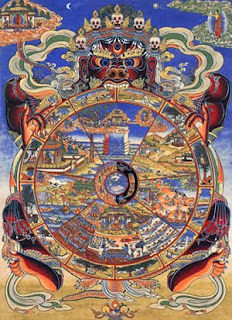IT IS VERY OFTEN POINTED OUT that the nidāna sequence is only the application of a general principle of conditionality to the specific case of rebirth or becoming (depending on how one interprets the nidānas). What if this idea, that the Buddha proposed a general theory of conditionality, is not true? I want to revisit an article by Eviatar Shulman in the Journal of Indian Philosophy [1] I've previously mentioned, and discuss one of his conclusions. He points out that what is traditionally thought of as the general principle of conditionality is:
imasmiṃ sati idaṃ hoti,
imass'uppādā idaṃ uppajjati;
imasmiṃ asati idaṃ na hoti,
imassa nirodha nirujjhati.
That being, this becomes;This formula occurs just 14 times throughout the Nikāyas, and not at all in the Vinaya. [2] What we don't often see is that this formula is, in all but one case, followed immediately by the nidānas. So at SN 12.21 (Dasabala Sutta):
with the arising of that, this arises.
That not being, this does not become
with the ceasing of that, this ceases.
Iti imasmiṃ sati idaṃ hoti, imassuppādā idaṃ uppajjati; imasmiṃ asati idaṃ na hoti, imassa nirodhā idaṃ nirujjhati - yadidaṃ avijjāpaccayā saṅkhārā; saṅkhārapaccayā viññāṇaṃ…pe… evametassa kevalassa dukkhakkhandhassa samudayo hoti.Note that the punctuation varies from place to place in the various Romanised versions of the Canon: sometimes the phrases are connected by hyphens or semi-colons, though of course Pāli traditionally employed no such punctuation; sometimes they are separated into separate sentences. The abbreviation "pe" occurs in the Pāli, especially in the Saṃyutta Nikāya, for well known lists such as the 12 nidānas. The phrase avijjāpaccayā saṅkhārā means 'with the condition of ignorance, there are volitions'.
A great deal of exposition on the Dharma relies on paṭicca-samuppāda being a general theory of conditionality. Nyanatiloka's Buddhist Dictionary entry on paṭicca-samuppāda is broadly representative and begins:
'dependent origination', is the doctrine of the conditionality of all physical and psychical phenomena... (p.154)For Buddhists all phenomena are explained by paṭicca-samuppāda. In the traditional account the twelve-fold nidāna sequence is a special case of paṭicca-samuppāda applied to becoming, or to rebirth, just as the 'Four Noble Truths' are that principle applied to suffering. Shulman's point is that this is not what the suttas say. His argument revolves around the connecting pronoun yadidaṃ (or yad idaṃ). He says:
"If yad idaṃ meant ‘for example’ or ‘such as,’ we could accept the view that the 12 links are a private case of a general principle of conditionality. But it clearly does not. What it does express is more akin to ‘that is,’ or more precisely ‘that which is’." (p.307)This proposition is quite startling. Shulman is not just proposing that we reinterpret an obscure piece of doctrine, but that we completely re-read the Buddhist tradition. I decided to take him seriously, and explore his hypothesis more fully.
The PED has a fairly full description of the use of yadidaṃ (s.v. ya˚, p.544b)
nt. yadidaŋ lit. "as that," which is this (i. e. the following), may be translated by "viz.," that is, "i.e." in other words, so to speak, just this, "I mean"; e.g. kāmānaŋ etaŋ nissaraṇaŋ yad idaŋ nekkhammaŋ "there is an escape from the lusts, viz. lustlessness"; or: "this is the abandoning of lusts, in other words lustlessness" It 61; dve dānāni āmisa˚ dhamm˚, etad aggaŋ imesaŋ yad idaŋ dhamma˚ "this is the best of them, I mean dh -- d." It 98=100; supaṭipanno sāvaka -- sangho, y. i. cattāri purisa -- yugāni etc. M i.37.There seems no necessity to restrict yadidaṃ to a narrow range of meaning based on etymology as in practice it is quite broad. Additionally Warder (Introduction to Pāli, p.292) suggests precisely the kinds of translations that Shulman says are not applicable: "such as, to wit, i.e., namely". So the case on this ground is not as strong as Shulman suggests.
The single exception to the imasmiṃ formula being followed by the nidānas (M ii.32 Cūḷasakuludāyi Sutta) seems to be inconclusive and Shulman dismisses it summarily. My opinion is that the 13 examples where imasmiṃ... is linked via yadidaṃ to the nidānas weigh against the singular exception. The context of the sutta - where the Buddha introduces the imasmiṃ formula but appears to be interrupted by Udāyin, who baulks at hearing the full teaching - supports the contention that this exception need not be construed as a standalone, but could equally be seen as a fragment, as an incomplete statement. In other words though I disagree with Shulman about yadidaṃ, I tend to agree that the exception does not definitely point to a different conclusion.
In search of some more conclusive evidence I looked for sentences which used the same locative absolute syntax as the 'general formula - Xlocative sati Y hoti. If we were to find the same syntax applied in different situations this would strengthen the 'general principle' case. It turns out that we do find other types of examples: for instance at D ii.276 we find a series of connected elements in the form:
kismiṃ sati issāmacchariyaṃ hoti? piyāppiye sati issāmacchariyaṃ hoti.The sequence runs:
When what exists is there envy? When there is pleasant and unpleasant, there is envy.
papañcasaññāsaṅkhaya → vitakka → chanda → piyāppiya → issāmacchariyaThere is no intersection with the nidāna sequence, but the same syntax is being used, suggesting that this syntax is not as specific as Shulman's claim would suggest. Having found a counter example we can say that Shulman's specific conjecture is refuted. The formula does have a more general, a more abstract sense.
However Shulman's wider point is this: "There is no reason to believe that dependent-origination originally discussed anything but mental conditioning" (p.307), and here I find we are in better agreement. In looking at this kind of syntax I did mostly find applications to mental process. However just one example of the Xlocative sati Y hoti construction is used as a simile which is suggestive. At S iv.172 the Buddha uses the example that "where there are hands, you get picking up and putting down" and similarly with the functions of the feet, limbs, and belly. These are cited to illustrate the application to mental processes, but they do show that the Buddha was aware of a more general application, even if it was not emphasised. As elsewhere the Buddha draws on nature for similes to illustrate his meaning, and this suggests that he saw similar processes in nature, though the similes all point one way - the mind is never a simile for what happens in nature.
The other aspect of the formula - X uppādā Y uppajjati - is much more restricted. I can find only one occurrence outside the context of the nidānas. At D ii.215 (Janavasabha Sutta) we find:
Tassa evaṃ jānato evaṃ passato avijjā pahīyati, vijjā uppajjati. Tassa avijjāvirāgā vijjuppādā uppajjati sukhaṃ, sukhā bhiyyo somanassaṃ.The relevant part is vijjuppādā uppajjati sukhaṃ - word order is not important here, and this is equivalent to vijjā uppādā sukhaṃ uppajjati. This confirms my earlier finding that though the formula is not tied specifically to the nidānas, it applies mainly to mental processes. It seems that Shulman has over-stated the case a little, but was not completely off the mark. Indeed his idea is confirmed by Sue Hamilton's findings in Early Buddhism: a New Approach, and some of the references he himself cites, particularly Collette Cox's investigation of the development of the theory of dhammas in the Sarvastivādin tradition. It is good to see scholars continuing to challenge the status quo and traditional orthodoxy. I found Shulman's paper very stimulating and thought provoking. I've focussed here on only one aspect of it and may return to some of his other points in other blog posts.
For one who knows and sees, ignorance wanes and knowledge arises. For that one, from the purification of ignorance and arising of knowledge, bliss and happiness arise.
This has clarified my thinking on paṭicca-samuppāda in a very useful way. The fact that there is even a single example of the kind - "when there are hands, there is picking up and putting down" - suggests that the Buddha did indeed see the idea of conditionality applying outside of mental processes - a hypothesis I have been arguing against for some time on this blog. That conditionality can be illustrated by similes drawn from nature tells us that the principle is more general. I don't think this changes the observation that the Buddha was concerned exclusively with mental processes as the source of disappointment; it changes the context a little, but not the focus.
~~oOo~~
Notes
- Shulman, Eviatar. 2008. 'Early Meanings of Dependent-Origination,' Journal of Indian Philosophy, 36(2): 297-317.
- The imasmiṃ formula occurs at: M i.263, ii.32, iii.63; S ii.28, 65, 70, 78, 79, 95, 96, v.388; A v.184; Ud 1, 2. All of the references in S ii are in the nidāna saṃyutta.
A much longer and more involved exploration of this subject can be found in this essay: Is Paṭicca-samuppāda a Theory of Everything?.





 T
T